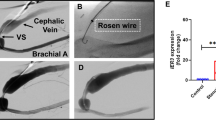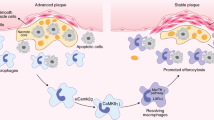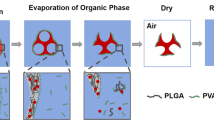Abstract
Nanospheres composed of the biocompatible and biodegradable polymer, poly-DL-lactide/glycolide and containing platelet-derived growth factor β-receptor antisense (PDGFβR-AS) have been formulated and examined in vitro and in vivo in balloon-injured rat restenosis model. The nanospheres (~300 nm) of homogenous size distribution exhibited high encapsulation efficiency (81%), and a sustained release of PDGFβR-AS (phosphorothioated). Cell internalization was visualized, and the inhibitory effect on SMC was observed. Partially phosphorothioated antisense sequences were found to be more specific than the fully phosphorothioated analogs. A significant antirestenotic effect of the naked AS sequence and the AS-NP (nanoparticles) was observed in the rat carotid in vivo model. The extent of mean neointimal formation 14 days after injection of AS-NP, measured as a percentage of luminal stenosis, was 32.21 ± 4.75% in comparison to 54.89 ± 8.84 and 53.84 ± 5.58% in the blank-NP and SC-NP groups, respectively. It is concluded that PLGA nanospheres containing phosphorothioated oligodeoxynucleotide antisense could serve as an effective gene delivery systems for the treatment of restenosis.
This is a preview of subscription content, access via your institution
Access options
Subscribe to this journal
Receive 12 print issues and online access
$259.00 per year
only $21.58 per issue
Buy this article
- Purchase on Springer Link
- Instant access to full article PDF
Prices may be subject to local taxes which are calculated during checkout







Similar content being viewed by others
References
Deshpande D, Rojanasakul Y . Antisense oligonucleotide therapeutics: a class of its own Pharma News 1996 3: 15–18
Stein CA . The experimental use of antisense oligonucleotides: a guide for the perplexed J Clin Invest 2001 108: 641–644
Akhtar S, Juliano RJ . Cellular uptake and intracellular fate of antisense oligonucleotides Trends Cell Biol 1992 2: 139–144
Mahato RI, Takakura Y, Hashida M . Development of targeted delivery systems for nucleic acid drugs J Drug Target 1997 4: 337–357
Cohen H et al. Sustained delivery and expression of DNA encapsulated in polymeric nanoparticles Gene Therapy 2000 7: 1896–1905
Ledley FD . Pharmaceutical approach to somatic gene therapy Pharm Res 1996 13: 1595–1614
Jong YS et al. Controlled release of plasmid DNA J Control Rel 1997 47: 123–134
Labhasetwar VA et al. DNA controlled-release coating for gene transfer: transfection in skeletal and cardiac muscle J Pharm Sci 1998 87: 1347–1350
Leong KW et al. DNA-polycation nanospheres as non-viral gene delivery vehicles J Control Rel 1998 53: 183–193
Chorny M, Fishbein I, Golomb G . Drug delivery systems for the treatment of restenosis Crit Rev Ther Drug Carrier Syst 2000 17: 249–284
Waltenberger J . Modulation of growth factor action: implications for the treatment of cardiovascular diseases Circulation 1997 96: 4083–4094
Fishbein I et al. Local delivery of platelet-derived growth factor receptor-specific tyrphostin inhibits neointimal formation in rats Arterioscler Thromb Vasc Biol 2000 20: 667–676
Fishbein I et al. Nanoparticulate delivery system of a tyrphostin for the treatment of restenosis J Control Rel 2000 65: 221–229
Hughes AD, Clunn GF, Refson J, Demoliou-Mason C . Platelet-derived growth factor (PDGF): actions and mechanisms in vascular smooth muscle Gen Pharmac 1996 27: 1079–1089
Noiseux N, Boucher CH, Cartier R, Sirosis MG . Bolus endovascular PDGFR-b antisense treatment suppressed intimal hyperplasia in a rat carotid injury model Circulation 2000 102: 1330–1336
Sirois MG, Simons M, Edelman ER . Antisense oligonucleotide inhibition of PDGFR-b receptor subunit expression direct supression of intimal thickening Circulation 1997 95: 669–676
Banai S et al. PDGF-receptor tyrosine kinase blocker AG1295 selectively attenuates smooth muscle cell growth in vitro and reduces neointimal formation after balloon angioplasty in swine Circulation 1998 97: 1960–1969
Waltenberger J et al. Ischemia-induced transplant arteriosclerosis in the rat. Induction of peptide growth factor expression Arterioscler Thromb Vasc Biol 1996 16: 1516–1523
Waltenberger J et al. A dual inhibitor of platelet-derived growth factor beta-receptor and Src kinase activity potently interferes with motogenic and mitogenic responses to PDGF in vascular smooth muscle cells. A novel candidate for prevention of vascular remodeling Circ Res 1999 85: 12–22
Villa AE et al. Effects of antisense c-myb oligonucleotides on vascular smooth muscle cell proliferation and response to vessel wall injury Circ Res 1995 76: 505–513
Ando S, Putnam D, Pack DW, Langer R . PLGA microspheres containing plamid DNA: preservation of supercoiled DNA via cryopreparation and carbohydrate stabilization J Pharm Sci 1999 88: 126–130
Ando S, Putnam D, Pack DW, Langer R . PLGA microspheres containing plamid DNA: preservation of supercoiled DNA via cryopreparation and carbohydrate stabilization Liversidge GG, Phillips CP, Cundy KC. Method to reduce particle size growth during lyophilization. United States Patent. Sterling Winthrop, New York, NY, USA, 1994.
Cleek RL et al. Inhibition of smooth muscle cell growth in vitro by an antisense oligodeoxynucleotide released from poly(DL-lactic-co-glycolic acid) microparticles J Biomed Mat Res 1997 35: 525–530
Abe J et al. Suppression of neointimal smooth muscle cell accumulation in vivo by antisense cdc2 and cdk2 oligonucleotides in rat carotid artery Biochem Biophys Res Commun 1994 198: 16–24
Bennett MR et al. Inhibition of vascular smooth muscle cell proliferation in vitro and in vivo by c-myc antisense oligodeoxynucleotides J Clin Invest 1994 93: 820–828
Edelman ER, Simons M, Sirois MG, Rosenberg RD . C-myc in vasculoproliferative disease Circ Res 1995 76: 176–182
Simons M et al. Antisense c-myb oligonucleotides inhibit intimal arterial smooth muscle cell accumulation in vivo Nature 1992 359: 67–70
Fishbein I et al. Drug delivery systems for the treatment of restenosis Wise DI (eds); Biomaterials and Bioengineering Handbook Marcel Dekker 2000 pp 313–335
Leppanen O et al. Intimal hyperplasia recurs after removal of PDGF-AB and -BB inhibition in the rat carotid artery injury model Arterioscler Thromb Vasc Biol 2000 20: E89–E95
Langer R . New methods of drug delivery Science 1990 249: 1527–1533
Juliano RL et al. Antisense pharmacodynamics: critical issues in the transport and delivery of antisense oligonucleotides Pharm Res 1999 16: 494–502
Rockwell P et al. Cell-surface perturbations of the epidermal growth factor and vascular endothelial growth factor receptors by phosphorothioate oligodeoxynucleotides Proc Natl Acad Sci USA 1997 94: 6523–6528
Stein CA et al. Dynamics of the internalization of phosphodiester oligodeoxynucleotides in HL60 cells Biochemistry 1993 32: 4855–4861
Weinstein R et al. Fibronectin dependence for attachment in vitro: smooth muscle versus fibroblast Sato GH, Pardee AB, Sirbasku DA (eds); Growth of Cells in Hormonally Defined Media Cold Spring Harbor Laboratory Press 1982 pp 145–154
Yamada KM, Kennedy DW, Hayashi M . Fibronectin in cell adhesion, differentiation, and growth Sato GH, Pardee AB, Sirbasku DA (eds); Growth of Cells in Hormonally Defined Media Cold Spring Harbor Laboratory Press 1982 pp 131–143
Golomb G et al. Controlled delivery of a tyrphostin inhibits intimal hyperplasia in a rat carotid artery injury model Atherosclerosis 1996 125: 171–182
Acknowledgements
This work was supported by a trilateral research grant (Wa 734/4-1) from the Deutsche Forschungsgemeinschaft to GG, MK and JW (coordinator).
Author information
Authors and Affiliations
Rights and permissions
About this article
Cite this article
Cohen-Sacks, H., Najajreh, Y., Tchaikovski, V. et al. Novel PDGFβR antisense encapsulated in polymeric nanospheres for the treatment of restenosis. Gene Ther 9, 1607–1616 (2002). https://doi.org/10.1038/sj.gt.3301830
Received:
Accepted:
Published:
Issue Date:
DOI: https://doi.org/10.1038/sj.gt.3301830
Keywords
This article is cited by
-
Silencing of skeletal metastasis-associated genes impairs migration of breast cancer cells and reduces osteolytic bone lesions
Clinical & Experimental Metastasis (2012)
-
Formulation of polylactide-co-glycolic acid nanospheres for encapsulation and sustained release of poly(ethylene imine)-poly(ethylene glycol) copolymers complexed to oligonucleotides
Journal of Nanobiotechnology (2009)
-
Enhancement in Anti-proliferative Effects of Paclitaxel in Aortic Smooth Muscle Cells upon Co-administration with Ceramide using Biodegradable Polymeric Nanoparticles
Pharmaceutical Research (2008)
-
Navigare necessere est
EMBO reports (2005)



